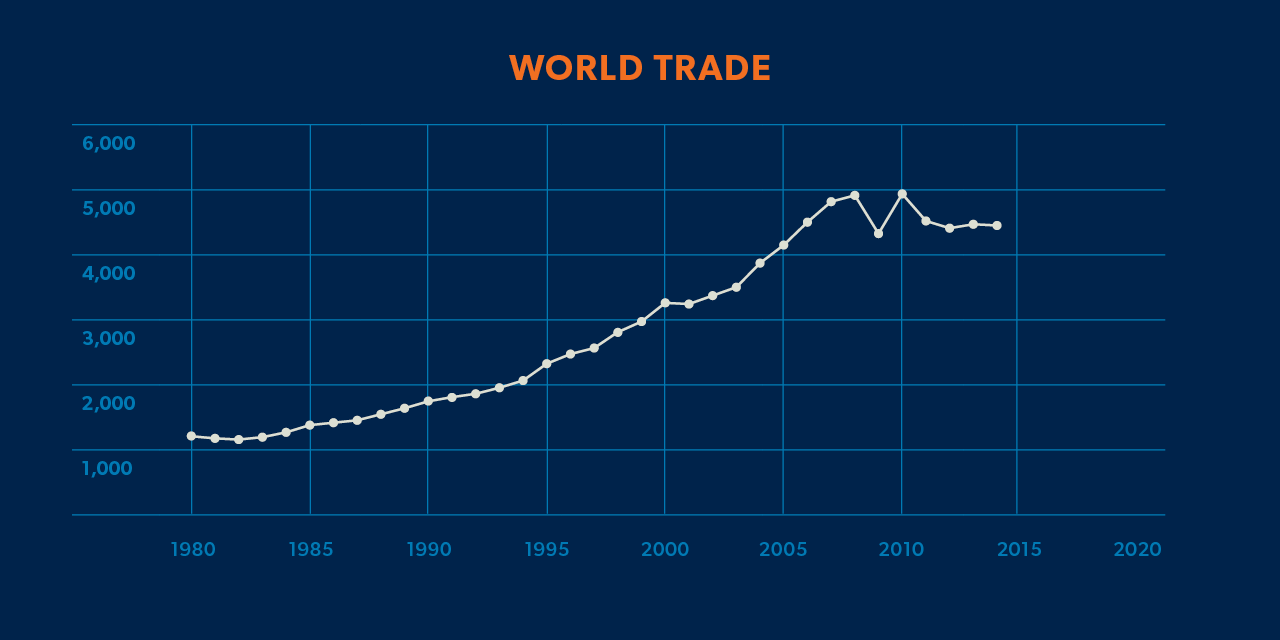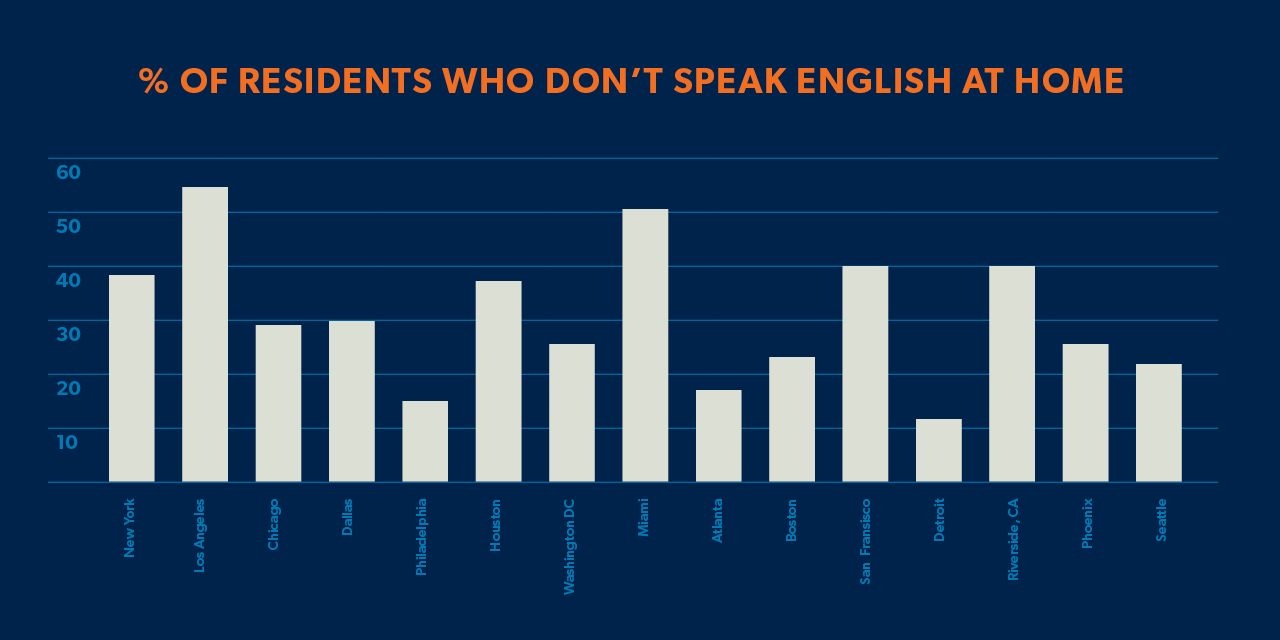
Language Translation: Identifying the right translator for your organization
Translation is about connections
Translation is more than a transaction. It’s a connection that bridges counties, cities, communities, and families. It’s personal, and it’s complex, filled with nuances that express individuality and respect diversity. It’s communication that has the power to bring us closer together or pull us farther apart. Above all, translation is human, and so are we.
Don't have time to read the whole guide right now? Download a copy and access it anytime.

The Importance of Language Translation is Growing
Connecting a global population.
It goes without saying that in the last 20 years, we've raced headlong into a global economy. Global trade has grown more than 25% in just the past twenty years. Thanks to the internet, the world has never been more accessible, with major cities and global markets only a click away. Airline travel has brought more people together than ever before; in 2019, airlines carried an estimated 4.45 billion passengers, a number that represents nearly half the world's population. While dramatic, these numbers don’t fully reflect the impact of our new economy.
With the global economy growing and barriers between global markets shrinking, eLearning is now a worldwide reality. From corporate training to online classes, companies and universities are adopting much more global approaches, broadcasting necessary information to audiences around the world. Scientific research increasingly relies on collaboration between colleagues thousands of miles and multiple countries apart. Even daily tasks – such as checking an app on your phone or ordering a product online – are made possible by tools created in part by developers from abroad.
The need for language translation now reaches far beyond accessing international markets or global trade. Today’s businesses need to focus on language translation as a critical component of Human Resources and marketing strategies. Since 1980, the number of non-English speakers in the United States has grown from 23 million to more than 65 million, a nearly 300% increase. Currently, 21.7% of the US population speaks a language other than English at home.
Any B2C business operating in the US that is only communicating with customers in English is missing over twenty percent of their potential customer base.
In many large cities, the numbers are even higher. From New York to Chicago, Los Angeles to Houston, US major metropolitan areas average between thirty and fifty percent of residents speaking a language other than English at home.
It's no wonder that schools, local governments, and many businesses understand the value of reaching people in their own language, and many are focusing heavily on language translation to meet residents' needs. As we move further into the 21st century, this need will only continue to grow. Fortunately, access to accurate translation is also growing.

What Makes a Great Translator
They’re certifiably better.
Once you’ve made the decision to use a professional translator, you’ll want to know how to sort the good from the bad (unfortunately, all translators are not created equal). Far and away, the most important distinction of a great language translator is ISO 17100 certification.
As we noted above, ISO 17100 guidelines are the highest standard of international translation. LinguaLinx follows these guidelines closely, and all of our certified language translators exemplify the competencies outlined in their standards.
-
Translation competence: This may seem obvious, but a translator must be able to comprehend and speak the language being translated.
-
Linguistic and textual competence in the source language and the target language: In addition to speaking a language, a certified translator must also know how to read and write in that language.
-
Competence in research, information acquisition, and processing: When it comes to any language, there is always something new to learn. This competency requires that a translator have the skills to research, learn, and understand new elements of the target language.
-
Cultural competence: A great language translator doesn’t just understand and speak a language, he or she is also well versed in its culture. This understanding enables a translator to accurately represent the language’s nuances and values.
-
Technical competence: When a translator is being asked to perform technical tasks as part of the translation process, it is essential that he or she has the knowledge and ability to do so. An example of this is medical translation; to prevent any life-threatening mistakes, a translator in this field must have a strong understanding of healthcare terminology.
-
Domain competence: A translator must have the ability to understand content produced in the source language, as well as the ability to reproduce it using the appropriate style and terminology.
In summary, it’s important to do your homework before hiring a translator. Accurate, appropriate language is too important to your message or initiative to leave its interpretation up to chance. Hire an ISO 17100 certified professional and you’ve hired a great translator.

Download this guide now for easy access anytime.
Why Hire a Language Service Provider
They’re certifiably better.
At the risk of sounding repetitive—but really, we can’t say it enough—hiring an ISO 17100 certified language service provider (LSP) for your translation needs is the most responsible and effective way forward. LinguaLinx has put together a quick checklist to help you know just what you’re looking for in a LSP and why.
Language depth
How many languages should your LSP provide? Short answer: all of them. While some languages and dialects are much less common than others, your LSP partner should be able to translate to different languages and meet all your requests. Your audiences are counting on you for this vital connection.

Localization
Localization takes into consideration the language and cultural subtleties of a target region or ethnicity. Recognizing these nuances opens the door to better connections with your audiences.
Centralized project management software
There are a number of benefits to working with an LSP that utilizes project management software.
First, it provides the secure transmission of sensitive or confidential information, a priority for any business or industry.
Second, it makes navigating multiple projects much more efficient and intuitive, allowing you to track projects with ease.
Industry expertise
To be a true partner, your LSP should understand the challenges faced by your business or industry. A customer service team with industry expertise will be better suited to meet your immediate needs and to help you think proactively.
ISO certification
(We have mentioned this once or twice before … ) Certification under the ISO 17100 Translation Services Management System is the international gold standard for language service providers. Working with an ISO certified team provides assurances that your LSP provides the highest level of technical accuracy.
Another benefit of hiring a certified translation company is that it can save you time and money. How? A certified LSP will guarantee your work is completed on time and on budget. Professional contracts will provide you with the pricing and parameters of your project, so there should be no surprises. LinguaLinx uses industry-standard rates and guarantees the quality of its work. In fact, we offer unlimited modifications at no additional cost.
As you can see, the benefits companies have from hiring a translator are plentiful—if they hire the right one. Ready to talk to an ISO 17100 certified language service provider? Contact LinguaLinx today.

Talk to us about your next translation project!

Technological Infrastructure
Numerous reasons to securely trust LinguaLinx.
LinguaLinx provides the highest level of corporate security to every client. You see, we view your work as a privilege, and respecting that privilege means providing you with complete confidence that your work is safe in our hands.
To make corporate confidentiality a top priority—even when working remotely during COVID-19—LinguaLinx has invested significantly in its security and infrastructure. Our clients benefit from:
Employee Training
-
PII Protect – Overall Employee Security Score consistently within the “low risk” area
-
Employees are required to take PII training on a regular basis and maintain their low risk rating
-
Employees are subjected to random phishing attempts
Data Center \ DR
-
Primary server stack housed in an SSAE 18 SOC 2 Type 2 facility (certificate available upon request)
-
Secondary\Backup infrastructure is replicated in Azure (ISO 27001:2013, 27018, HIPPA, DPA Certified)
-
Bi-annual DR testing, with an annual complete cut-over test (reports available upon request)
-
LLX combination of physical colocation along with virtualized cloud services ensures reliability and scalability to meet any need
-
Redundant backbone links in the datacenter
-
Employees able to cover multiple time zones with 24x7x365 IT support
Security
-
Bi-annual penetration testing and network vulnerability scans are performed (results available upon request)
-
Securely locked building; office accessible by mobile app
No matter who you partner with for your translation needs, be sure they can offer the highest level of security possible. You deserve the peace of mind.

Translation Pricing
Seven factors worth knowing.
Understandably, price is an important factor when deciding which language service provider (LSP) to use. Unfortunately, some choose to use an uncertified or machine translator because they think it’s a better bargain. Before you go searching for “machine translation pricing,” LinguaLinx wants to share how our pricing is determined so that you can make a well-informed decision.

Fact: each translation project is unique. This means that we can’t tell you how much a translation will cost until you request a formal quote. Here are the factors that influence pricing for translation projects.
The number of source words: We believe estimates based on word count offer the most accurate measure of the time and work required for a translation. LinguaLinx uses a pay-per-word rate to ensure clients get the most cost-effective pricing possible.
Timeframe: While LinguaLinx strives to provide an efficient timeframe to complete a project, those which require an immediate or shorter-than-average turnaround may incur costs above our standard rates.
Language combination: The complexity of some languages may mean there are fewer certified linguists available for translation; this factor, along with the complexity, may lead to higher rates.
The complexity of the subject matter: Factors such as the need for industry-specific expertise or considerable formatting can affect a project’s pricing.
TEP process: All LinguaLinx estimates include the cost of our Translation, Editing, and Proofreading (TEP) process. This thorough approach ensures every project is accurate and culturally appropriate. It’s important to know that if a project does not go through the editing process, it is not certified.
Translation software tools: Every LSP uses a variety of software tools. While some, like localization software, can lead to a higher price point, others can actually lower a client’s costs. Translation Memory is a tool that recalls previously translated words and phrases; LinguaLinx offers discounts based on the number of repeated words.
Hidden costs: It’s important to know that some translation agencies charge an extra/hidden fee to cover project management and overhead costs. Before you sign a contract, make sure all fees are clearly specified. LinguaLinx always provides a detailed estimate, making clear any fees involved with your project.
As you can see, there is a good deal of consideration that goes into a project quote. You can be confident that LinguaLinx will always provide a thorough and fair estimate. Unlike some others, we promise to be transparent in our pricing and will never charge you any hidden fees.

Project Management
You've probably heard the old adage, "time is money." In this case, words are money. When words are translated incorrectly, it can cost you millions in lost revenue and negative brand exposure. Money is not the only thing you could lose; medical translation errors could impact the health and wellbeing of others. Product translations, from technical manuals to marketing materials, are key for maintaining and growing your customer base. E-learning translations can directly impact the expertise and efficiency of your workforce.

Regardless of your translation and localization project's size, from a quick two-page project to one encompassing hundreds of documents and millions of words, the unsung heroes of any translation project are your project managers. The quality assurance you should expect requires dedicated project managers to ensure every detail is accounted for, and your translation team works in concert.
Previously we covered how ISO 17100 certification applies to linguists and subject matter experts, yet project management is an even bigger factor in the certification than the translators themselves. Over half of ISO 17100 standards and documentation focus on the competencies of project managers and the processes to ensure language translation services are completed correctly and on time. Covering all aspects from the initial project scope to translation, review, proofreading for clarity, and even post-project client feedback, Project management is arguably the number one factor determining the success of your translation.
What makes a great project manager?
Instead of answering this ourselves, here are some insights from a few of the best project managers we know.
-
Stamina – "My previous mentor called project management a 'sink or swim' role. Most days are fast-moving. Some projects have a high volume of work associated with it. You have to be able to give it all you have and then a little more. Be adaptive, not reactive. Or as Dory says, 'just keep swimming!'" ~ LinguaLinx project manager Lily Kahrs
-
Prioritizing – "You have to plan your day around knowing what's going to take you longer, but leave enough time for the tasks that come up throughout the day. Time management goes hand in hand with prioritizing. Be proactive and communicate early and often. There's no harm in following up." ~ LinguaLinx project manager Andrew Slawsky
-
Multitasking – "Most tasks are time-sensitive and concurrent, meaning that you have to stay on top of everything throughout an average day. It's easy to get overwhelmed when there are many moving pieces, so it's important to take each task one at a time so as not to get stressed." ~ LinguaLinx project manager Allison Saillard
-
Staying Organized – "Utilize a live tracker that can be filtered by the due date, client, etc. This way, you can see all projects and manage your time. Another sure way to stay organized is to ask your questions ahead of time to ensure the project runs smoothly and is completed on time." ~ LinguaLinx project manager Jolene Marble

Planning Your Translation Project
Preparation is key.
Getting started with LinguaLinx is as simple as the click of a button; we work hard to make our process as convenient and enjoyable as possible. In preparation of your project, there are a number of steps you can take to further ensure its timely (and cost-effective!) success.
-
Submit your content in Word or Excel files—screenshots or other file formats can take more time to process.
-
Plan ahead and skip the rush—rush fees caused by immediate or tight timeframes can add unnecessary expense to your project.
-
Send the final version—submitting a complete file will allow us to provide you with an accurate estimate and timeframe.
-
One file is best—by consolidating all your elements into one document, you are allowing our team to be more efficient and cost-effective
-
Don’t send duplicate materials—multiple copies of the same document can cause confusion and delay work, especially if your project requires multiple translators.
Create a translation glossary—this useful tool includes a list of all the key terms, definitions, and preferred translations for your brand. The glossary will help guide your linguist on the proper way to represent your company and materials.
Never let the process overwhelm you. LinguaLinx is your translation partner, and we will always be there to ensure your project is done exactly the way you need it. We are humans connecting humans.
Get it done right the first time. Our Translation, Editing, and Proofreading (TEP) process provides multiple touch points throughout the translation project to ensure your work is done correctly and quickly!
Subscribe via Email
Subscribe to our blog to get insights sent directly to your inbox.




